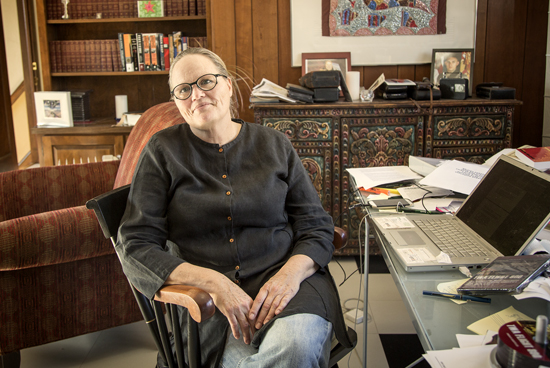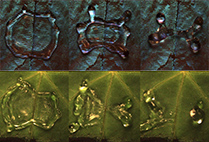On the afternoon of July 17, 1996, broadcast journalist Kristina Borjesson left work early after wrapping up a documentary on Fidel Castro for CBS. Her husband was at JFK International Airport, putting their 11-year-old son on a plane to visit relatives in France, and an exhausted Borjesson climbed into bed for a nap.
“All of a sudden the phone rang,” she says, “and I heard my neighbor’s voice say, ‘Was that your son’s plane that just went down?’” A Paris-bound Boeing 747 had exploded off the coast of Long Island, N.Y., just after 8:30 p.m., killing all 230 on board. “I can’t even describe to you that feeling,” says Borjesson (COM’80). “It was like hot oil was poured on my brain. I started dry-heaving.”
But her son was safe; his Air France flight was five minutes behind the doomed aircraft, TWA Flight 800. “For that moment, I knew what the family members of those victims were going through,” she says. “I lived it.”
The tragedy would remain part of Borjesson’s life for the next 17 years, the subject of her own on-again, off-again investigation. Her documentary, TWA Flight 800, which she wrote, directed, and produced, premiered on the EPIX cable TV channel last July. It is the first film, she says, to focus entirely on the forensic evidence, and it disputes the conclusions of the National Transportation Safety Board (NTSB), which spent four years investigating the accident.
In 2000, following what the NTSB described as the most extensive and complex probe in its history, the safety board determined that TWA Flight 800 was brought down by an explosion of the center wing fuel tank. Although the cause could not be established, it said, it was most likely the result of a short circuit in the electrical wiring outside the tank.
But some, including Borjesson, questioned the explanation. She and Tom Stalcup, film coproducer and a physicist who began looking into the accident on his own time shortly after the explosion, charge that the FBI stepped in early and sidelined the experts in aviation investigation: the NTSB. They believe that debris from the fuselage was mishandled, and that the accounts of dozens of eyewitnesses who recalled seeing the same thing—three fast-moving missile-like objects streaking up into the sky toward the plane before the fireball—were ignored or rejected. The documentary is available for streaming on Netflix.
“This was an investigation that was corrupted and undermined,” says Borjesson. “The forensic evidence and eyewitness accounts clearly show that there was ordnance external to the airplane involved in this crash. And that does not fit the government’s official probable cause assessment of what happened, which is a low-velocity deflagration in the center wing fuel tank caused by a spark, the origin of which they have never found. So they closed this investigation before they could even find the ignition source for what they were claiming happened.”
The documentary features several members of the original investigation team, along with eyewitnesses to the crash. In June 2013, they were joined by some of the family members of crash victims in filing a petition asking the NTSB to reopen the case. The safety board is reviewing the petition.

Borjesson says her documentary is the first film to focus entirely on the forensics of the plane crash, and it disputes the NTSB’s conclusions. Photo by Beth Perkins
Smoking Gun?
When Borjesson returned to work at CBS the day after Flight 800 went down, she was assigned to look into the crash. She ran into trouble after receiving a piece of seat foam from the wreckage, which she’d planned to have tested for traces of solid rocket missile fuel. Borjesson says that the man who had received the foam from a member of the official investigation and sent it to her for testing had every right to do so, but the FBI came calling and claimed it was stolen. “CBS, much to my chagrin and dismay, returned it immediately,” she says, “and I was given my walking papers a few weeks after that….That told me that the story was controversial, that there were limits to the freedom of the press. And it really tore my guts out, because I was so happy at CBS. I’d just won an Emmy for investigative reporting, and I was on a roll.”
In 1998, Borjesson was invited to produce a segment on TWA Flight 800 for the pilot program of a new television series called Declassified, to be hosted by Oliver Stone. Shortly after accepting the assignment, her car was broken into and documents and a computer stolen. Then, articles began appearing in the press: “Conspiracy crank Oliver Stone is doing a missile show on TWA” was the gist, she recalls. ABC canceled the show. Over the years, she has been invited to speak publicly about the crash, typically on the anniversary.
Stalcup, meanwhile, had been amassing information about the accident, talking to eyewitnesses and evaluating their accounts, analyzing technical reports, and requesting information from the government through the Freedom of Information Act. He believes he uncovered the smoking gun: Federal Aviation Administration radar data showing unexplained debris flying away from the plane at four times the speed of sound. That, he says, is much faster than if there had been a fuel tank explosion. He called the NTSB and the media, but says he was unable to generate any interest in his findings.
“There’s enough in the public domain now for any scientist to conclude that the official theory is wrong,” Stalcup says.
He turned to Borjesson, whom he’d met about a year after the crash. “I said, ‘Kristina, we have to do this ourselves.’” It turned out their timing was right. Henry Hughes, an NTSB senior accident investigator who had been part of the government’s Flight 800 investigation, had just retired. Once he agreed to work with Borjesson and Stalcup, several other former investigators came forward, too. Soon EPIX was on board, agreeing to fund and broadcast the documentary.
The film stops short of theorizing about the source of the streaking objects seen by eyewitnesses. That was by design. Borjesson says she and Stalcup included only information they could document and verify. Borjesson herself declines to speculate. “My position is very vulnerable,” she says. “If you look at the history of my career, you can see just how vulnerable I am.” Stalcup is a bit less cautious. “The three objects may seem strange to the layperson,” he says, “but those familiar with missiles will tell you that that number of objects in the sky at the same time is not in the least bit strange.”
The NTSB discounted the possibility of a missile strike in its 2000 determination. “NTSB investigators examined every piece of wreckage for any physical evidence that the crash of Flight 800 could have been caused by a bomb or missile,” the board said at the time. “No such evidence was found.”
Stalcup says he is trying to get more information from the US Department of Defense’s Missile Defense Agency.
The bottom line, he says: “No one has yet challenged anything factual in our documentary.” The two maintain their own media fact-checking page on their website, www.flight800doc.com.
Lives Destroyed
Borjesson, who holds a master’s from Columbia University’s School of Journalism, has produced for networks such as CBS, CNN, PBS, and Arte in France. She won Emmy and Edward R. Murrow Awards in 1995 for investigative reporting for the documentary Legacy of Shame, about migrant farmworkers in the United States, and she was nominated for an Emmy for the Castro documentary, The Last Revolutionary. She’s also published two books, Into the Buzzsaw: Leading Journalists Expose the Myth of a Free Press (Prometheus Books, 2002) and Feet to the Fire: The Media after 9/11 (Prometheus Books, 2005), and she lectures on investigative reporting and the press.
She says she felt a responsibility to the retired investigators and the eyewitnesses who participated in the documentary, as well as to the flying public and the victims’ families. She remembers one family member telling her that her husband had left her because she’d booked their daughter on Flight 800.
It reminded Borjesson of the conversation she’d had with her own husband about which flight to put their son on in 1996. “My husband is French; he said, ‘This TWA flight is much cheaper,’ and I said, ‘Well, go for that,’” Borjesson says. “And he said, ‘No, Air France is better. It’s a state-run airline, and their maintenance record is far superior.’ I said, ‘In that case, go for that.’ But I was right there in that woman’s shoes for two seconds. Besides the victims, people’s lives were destroyed. Their families were destroyed. And it could have been any one of us.”

















































Obviously a cover-up when they don’t need the eyewitness accounts. Bloody awful…!
I’m looking for a retired navy crewman on a missile destroyer to admit they often practiced in that area due to the availability of so many targets.After our radar would search and lock on a target we would track its speed distance altitude etc. Then instead if shutting down the launch command was activated…we were helpless to stop it…
TWA Flight 800 accident opinion, short revised version of six pages submitted to FAA and NTSB in 1996.
On 19 July 1996, a 747 had been parked for four hours at JFK airport, while its airconditioner pack heated an almost empty center wing tank (CWT); making fuel vapors even more volatile. After loading, TWA Flight 800 took off and headed for Paris. At 8:31 PM and 11 miles south of Long Island, NY, the CWT exploded while the 747 was climbing towards its assigned 15,000 foot altitude. All 230 people onboard died as a result.
Pilots of Eastwind Airlines Flight 507, descending to 16,000 feet, were nearly head-on and observed the 747 as it climbed towards them in the clear air. One pilot radioed he saw a light appear on the 747 and flashed his landing lights in greeting, then the 747 exploded. The pilot reported two fireballs going down, with small and large smoke trails. Many nearby pilots also radioed they saw the event, with no mention by any pilot of seeing anything other than the 747, its explosion, then two smoke trails and a crash site.
Pilot interviews should have been standard procedure for the National Transportation Safety Board (NTSB). Unfortunately, no one seems to have interviewed these pilots; including FAA, FBI, media, etc.
Having been a researcher of one cause of uncontained aircraft engine failures for the Air Force, I immediately suspected that parts from an uncontained engine failure had ignited the volatile vapors in a fuel tank; like so many other aircraft crashes before this one, including other 747s.
Initially, I was sure the NTSB investigators interviewed these pilots and came to the same conclusion. Had the NTSB promptly revealed pilot interviews, the public might have been spared the hundreds of hours and thousands of pages of testimony created by “witnesses.” These were people, 11 or more miles away, who said they saw a missile rise upward from the sea and explode against the 747; some in great detail.
Several people then claimed these witness’ reports were evidence of “Friendly Fire” by a missile from a Navy vessel or a terrorist attack. Related stories became national, even international news, resulting in TV shows and books. But there was no mention by the pilots of any missile smoke trail coming up and only two going down. In addition, other witnesses reported they only saw flaming objects falling from the sky and most only after hearing the sound of an explosion; more than one minute after the event.
The descending “streak of light” and smaller smoke trail seen by pilots and other witnesses on land, was most likely engine #3 (right inboard, next to CWT) after it separated from the aircraft and fell, burning, rearward into the sea, miles short of the main debris field. Engine #3 was found much later, seen torn apart in recovery photographs and clearly an uncontained engine failure. However, the found location of engine #3 was changed by the NTSB to the debris field, preventing others from knowing exactly where it separated.
After most of the aircraft was recovered, the NTSB reported the CWT had exploded. Then the NTSB produced a movie showing the aircraft blowing apart, with the main section climbing several thousand feet, then falling with all four engines in place. However, the aircraft was only seen descending by airline pilots shortly after it exploded, with a small smoke trail behind that was most likely engine #3.
Uncontained engine failures can be very destructive, ejecting parts as far as three thousand feet and often destroying any adjacent engines. Uncontained engine part entry holes riddled the right side of the 747, with one part embedded in the tail section. However, unknown individuals were later seen pounding on recovered fuselage panels with hammers, effectively destroying evidence of engine part entry holes. Then the NTSB’s Final Report stated there was “No evidence of any engine uncontainment.”
I wrote to the FAA and NTSB, sure that people with more experience and qualifications would know the cause was a classic uncontained engine failure. Only the FAA replied, with nearly 2,000 accident reports, including many with uncontained engine failures and fatal crashes of 747s. Shortly after that, two men visited me one night and told me to cease my unqualified efforts as it might “prove harmful.” I did till now.
While the NTSB Final Report suggested defective wiring insulation inside the CWT to be the most likely origin of the fuel vapor ignition and explosion, no clear cause was ever determined by the NTSB.
I created a petition to see about opening this investigation back up. Please sign and share!
https://petitions.whitehouse.gov/petition/re-open-investigation-twa-800-plane-crash/L57zGrMM
I worked on a ground crew at JFK that day and watched Flight 800 take off while on a rest break. A while later, the guys came out and said: go into the break room; a “T-Way” (TWA) 747 crashed off Long Island. I followed the ever-changing story and knew something was wrong. With the internet I followed Commander Donaldson’s ARAP website up until he died of fast-acting brain cancer right before 9-11. Donaldson was not going to quit. It was through that source I learned of the undeniable technical evidence for a missile shootdown. As much as I love the CBS program 60 Minutes, I no longer watch it due to the fatal violation of both journalism and democracy it committed against Ms. Borjesson. The same rogue shadow government group that murdered the Kennedy brothers also flagrantly denied true democracy to its citizens in its criminal violation of the investigation into Flight 800’s crash. As President Truman wrote in a Washington Post editorial a month after JFK’s death, we have a government that has strayed off its path since the creation of the Central Intelligence Agency. The CNN presentation of a 2-hour government propaganda program on the 10th anniversary is also why I no longer watch CNN. Citizens who practice genuine democracy will not suffer the insult of being slandered as “conspiracy theorists.” This wrong will be righted. God bless Ms. Borjesson for practicing that which others have betrayed.
Thank you four your courage and determined research. This tragedy has been in my thoughts since it happened, but what has haunted me has been the realization that a deceptive narrative was spun before my eyes…and was accepted as fact by our media. It was a watershed moment for me, as I have never looked at another news story the same way since. I sincerely hope that the investigation is reopened and the truth is finally known.